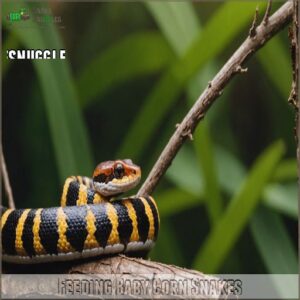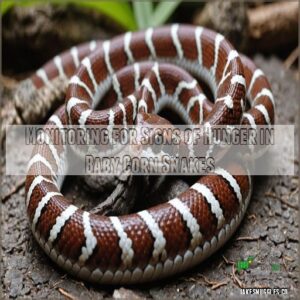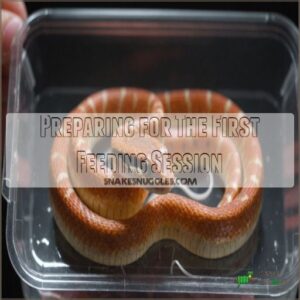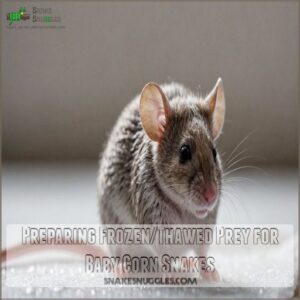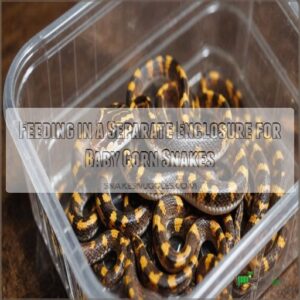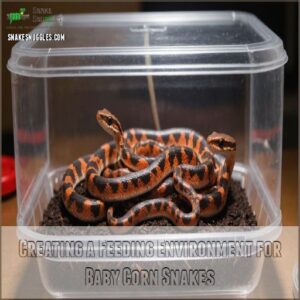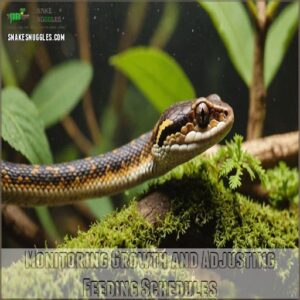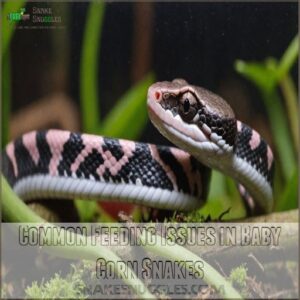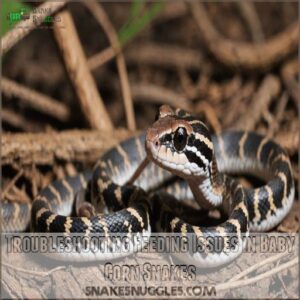This site is supported by our readers. We may earn a commission, at no cost to you, if you purchase through links.
 You’ll want to start feeding your baby corn snake 5-7 days after their first shed, which typically happens a week after hatching.
You’ll want to start feeding your baby corn snake 5-7 days after their first shed, which typically happens a week after hatching.
Just like human babies, these tiny serpents need time to adjust to their new world.
Look for clear signs they’re ready: active tongue flicking, exploring their enclosure, and showing interest in movement.
Start with pinkie mice about the same width as your snake’s widest body point.
Temperature matters – keep their enclosure between 75-85°F for the best digestion.
Proper timing and technique make all the difference between a successful first meal and a frustrating refusal.
The secret’s in the details of prey preparation and presentation.
Table Of Contents
- Key Takeaways
- Feeding Baby Corn Snakes
- When to Start Feeding Baby Corn Snakes
- Preparing Frozen/Thawed Prey for Baby Corn Snakes
- Feeding Techniques for Baby Corn Snakes
- Creating a Feeding Environment for Baby Corn Snakes
- Handling Baby Corn Snakes After Feeding
- Vitamin Supplements for Baby Corn Snakes
- Monitoring Growth and Adjusting Feeding Schedules
- Common Feeding Issues in Baby Corn Snakes
- Troubleshooting Feeding Issues in Baby Corn Snakes
- Frequently Asked Questions (FAQs)
- Conclusion
Key Takeaways
- You’ll need to wait 5-7 days after your baby corn snake‘s first shed, which typically happens a week after hatching, before starting to feed them. Baby corn snakes can go without eating for weeks but it’s essential to establish a feeding routine early on to ensure proper growth and health.
- You should choose pinkie mice that match your snake’s mid-body width and dust them with calcium powder twice weekly and multivitamins once weekly.
- You’ll want to maintain your snake’s enclosure temperature between 75-85°F and wait at least 48 hours after feeding before handling them.
- You can encourage feeding by using tongs to wiggle the properly thawed and warmed prey, and always feed your snake in a separate, clean enclosure to prevent substrate ingestion.
Feeding Baby Corn Snakes
You’ll start feeding your baby corn snake a pinkie mouse, which should be about 1 to 1.5 times the snake’s widest point, according to the correct prey size guidelines, shortly after it hatches, though it’s normal for hatchlings to wait until after their first shed.
While young snakes can be picky eaters, you can encourage them to eat by using feeding tongs, warming the pinkie properly, and maintaining the right temperature in their enclosure.
Nutritional Requirements of Baby Corn Snakes
Because baby corn snakes are rapidly growing, they need a carefully balanced diet rich in protein and essential nutrients.
Calcium supplementation is essential for young corn snakes.
You’ll need to dust prey items with a calcium powder twice weekly and provide a multivitamin supplement once weekly.
This feeding regimen supports healthy growth and prevents common nutritional deficiencies like metabolic bone disease.
Choosing The Right Prey for Baby Corn Snakes
Selecting the right prey size is crucial as corn snakes require a diet of whole animal prey approximately 1.5 times the width of the snake’s midsection, optimal prey selection. Selecting the right prey size directly impacts your baby corn snake‘s health and growth.
For hatchlings, pinkie mice offer the perfect nutritional balance, matching your snake’s mid-body thickness.
When feeding baby corn snakes, you should follow a consistent feeding schedule, as outlined in expert baby corn snake care guides like this one on baby corn snake feeding.
- Choose prey that’s slightly smaller than your snake’s widest point
- Stick to commercially bred frozen pinkies for consistent quality
- Store frozen prey at 0°F for up to 6 months
- Gradually increase prey size as your snake grows
Safety Precautions When Feeding Baby Corn Snakes
While feeding baby corn snakes might seem straightforward, safety should always come first.
Use feeding tongs to prevent accidental bites and maintain a proper distance during feeding.
Never handle your snake with bare hands immediately after it’s eaten, as this can cause stress or regurgitation.
Keep the enclosure door partially closed during feeding to prevent escape, and always wash your hands thoroughly afterward.
When to Start Feeding Baby Corn Snakes
You’ll need to wait until your baby corn snake has completed its first shed, typically 1-2 weeks after hatching, before offering its first pinkie mouse.
Active tongue flicking and exploring behavior are signs that your snake is ready to eat.
Once your snake shows active tongue flicking and exploring behavior, you can start a regular feeding schedule with appropriately sized prey that matches your snake’s mid-body thickness.
Age and Size Considerations for First Feeding
Most baby corn snakes are ready for their first meal 7-10 days after hatching, typically after their first shed.
Your hatchling should measure between 8-12 inches long before attempting that initial feeding.
A pinkie mouse, measuring no thicker than your snake’s mid-body, makes the perfect first meal.
Remember to weigh your snake regularly – healthy hatchlings should gain 3-4 grams between feedings.
Monitoring for Signs of Hunger in Baby Corn Snakes
Baby corn snakes show clear hunger signals once they’re ready to eat.
You’ll notice increased activity, especially during their usual feeding frequency guidelines, and more frequent tongue flicks exploring their environment.
Watch for your snake actively searching around their enclosure or spending time near their feeding spot.
A healthy snake will also display good body condition and consistent weight, while refusing food might indicate stress or illness.
Preparing for The First Feeding Session
Getting ready for your corn snake’s first meal requires careful preparation.
You’ll need clean feeding tongs, an appropriately-sized pinkie mouse (thawed to room temperature), and a quiet feeding area.
Set up proper lighting conditions – dim lights often work best – and make sure the enclosure temperature stays between 75-85°F.
Keep handling tools sanitized and your movements slow to avoid startling your new pet.
Preparing Frozen/Thawed Prey for Baby Corn Snakes
To properly prepare frozen prey, thawing frozen rodents in the refrigerator overnight using safe thawing practices. You’ll need to properly prepare frozen prey before feeding your baby corn snake to make sure safe and successful meals.
Frozen prey must be thawed and warmed to the right temperature, which helps trigger your snake’s natural feeding response.
While the process might seem tricky at first, you’ll quickly master the essential steps.
Thawing Frozen Prey Safely for Baby Corn Snakes
Properly thawing frozen prey is a cornerstone of safe corn snake feeding.
Place the frozen pinkie in a sealed plastic bag and submerge it in cool water for 15-20 minutes.
Never use hot water or microwaves, as they can cook the prey from the inside out.
Once thawed, pat the pinkie dry with paper towels to remove excess moisture.
Warming Up Thawed Prey for Baby Corn Snakes
After thawing, warming your snake’s prey to the right temperature can make all the difference in feeding success. You’ll want to aim for about 100°F – just like their natural prey would be.
Here’s how to nail the warming process:
- Use a warm water bath (not hot) for 5-10 minutes
- Keep the prey in a sealed plastic bag while warming
- Monitor temperature with a probe thermometer
- Never use a microwave or direct heat source
Checking Prey Quality for Baby Corn Snakes
Before offering prey to your baby corn snake, inspect it thoroughly for any signs of damage, discoloration, or freezer burn.
Check that the pinkie’s body is fully thawed and pliable, without cold spots or ice crystals.
Consider warming thawed prey in warm water (90°F to 100°F) for a few minutes, as recommended for Frozen/Thawed Prey Preparation.
A quality prey item should have intact skin, no foul odors, and maintain its natural coloring.
Store unused pinkies in an airtight container to prevent freezer burn.
Feeding Techniques for Baby Corn Snakes
You’ll find that feeding your baby corn snake requires careful technique and attention to specific safety measures that guarantee both you and your pet stay safe during mealtimes.
Using the right tools and following proper handling procedures will help you establish a successful feeding routine that promotes healthy growth and natural hunting behaviors in your young snake.
Using Forceps or Tongs for Safe Handling
Long-handled feeding tongs are your best friend when handling prey for baby corn snakes.
You’ll want to grip the pinkie mouse firmly near its midsection using 12-inch stainless steel tongs – this keeps your hands safely away from any accidental strikes.
Choose tongs with serrated tips for better control, and always check that they’re clean and dry before each feeding session.
Encouraging Hunting Behavior in Baby Corn Snakes
Most baby corn snakes naturally possess hunting instincts, but you can enhance their feeding response through smart techniques.
Try gently wiggling the pinkie mouse with tongs to mimic prey movement.
If your snake seems hesitant, scenting the prey with used bedding from a feeder mouse cage can trigger their predatory drive.
For particularly shy feeders, container feeding lets them hunt in a more confined, stress-free space.
Feeding in a Separate Enclosure for Baby Corn Snakes
Setting up a separate feeding enclosure for your baby corn snake reduces stress and keeps their main habitat clean.
You’ll want a simple plastic container with air holes and proper substrate.
This setup prevents accidental substrate ingestion and makes it easier to monitor their eating habits.
Remember to handle your snake gently during transfers and give them time to adjust to the new environment.
Creating a Feeding Environment for Baby Corn Snakes
You’ll need to set up a secure feeding space that includes the right temperature gradient and multiple hiding spots to help your baby corn snake feel safe during mealtime.
Making sure the environment is clean and properly heated will encourage natural feeding behaviors and reduce stress for your young snake.
Providing a Temperature Gradient for Baby Corn Snakes
A proper temperature gradient helps your baby corn snake digest food effectively.
Think of it like a thermal buffet – your snake needs options to regulate its body heat during and after meals.
- Maintain a warm side at 85-88°F for digestion
- Keep the cool side at 75-80°F for thermoregulation
- Place the heat mat under 1/3 of the enclosure
- Monitor temperatures with two separate thermometers
These temperature zones let your snake move between warmer and cooler areas as needed, just like they’d in nature.
Ensuring Hiding Places and Security for Baby Corn Snakes
Baby corn snakes need secure hiding spots to feel safe while eating.
Place at least two snug hideouts on both the warm and cool sides of their enclosure.
Think of it like having cozy corners in your own home – your snake wants that same sense of security.
Cork bark rounds, commercial hides, or even clean cardboard boxes work well.
Just make sure the hideouts are slightly larger than your snake when coiled.
Maintaining a Clean Environment for Baby Corn Snakes
A spotless feeding environment keeps your baby corn snake healthy and thriving.
You’ll want to clean the substrate weekly, removing any waste or leftover food promptly.
Disinfect feeding tongs between uses and maintain a fresh water source daily.
Consider using disposable feeding containers to prevent bacterial growth.
Keep the humidity balanced and check regularly for signs of mold or mites in the enclosure.
Handling Baby Corn Snakes After Feeding
You’ll need to wait at least 48 hours after feeding your baby corn snake before handling it, as this gives your pet time to properly digest its meal.
During this important period, you’ll want to maintain a consistent temperature in the enclosure and minimize any disturbances that could stress your snake or interfere with digestion.
Waiting Period After Feeding Baby Corn Snakes
After feeding your baby corn snake, it’s very important to maintain a hands-off approach for at least 48 hours, especially considering their feeding frequency, which should be every 5-7 days for hatchlings as outlined in proper corn snake feeding practices.
This waiting period allows your snake to digest its meal without stress or interruption.
During this time, avoid cleaning the enclosure unless absolutely necessary.
Think of it like respecting someone’s post-dinner nap – your snake needs this downtime to process its meal properly and maintain healthy digestion habits.
Signs of Digestion and Safety in Baby Corn Snakes
Once you’ve given your snake some space post-meal, watch for these clear signs of healthy digestion:
- A noticeable belly bulge that gradually shrinks over 2-3 days
- Normal activity levels resuming within 48-72 hours
- Regular bowel movements with dark, well-formed droppings
- A potential shed cycle beginning 5-7 days after feeding, and remember to obtain the right food and supplies for the next meal by shopping for Baby Corn Snake Food.
These signs tell you your snake’s digestive system is working like a well-oiled machine.
Safe Handling Techniques for Baby Corn Snakes
Proper handling helps your young corn snake stay calm and healthy during care routines.
While your snake digests, maintain these handling guidelines to minimize stress:
| Time Period | Handling Duration | Safety Tips |
|---|---|---|
| First 24 Hours | No handling | Keep enclosure undisturbed |
| 24-48 Hours | 5 minutes max | Support entire body length |
| 48-72 Hours | 10 minutes max | Watch for stress signs |
| After 72 Hours | Normal routine | Handle gently, avoid sudden movements |
Vitamin Supplements for Baby Corn Snakes
To ensure your baby corn snake is receiving a balanced diet, it’s essential to understand what corn snakes eat in the wild and in captivity, including their varied diet of small rodents and birds. You’ll need to dust your baby corn snake’s prey with calcium and multivitamin supplements to prevent common health issues like metabolic bone disease.
A weekly dusting schedule with a 50/50 mix of calcium and multivitamins will give your growing snake the nutrients it needs for healthy development.
Importance of Calcium and Multivitamins for Baby Corn Snakes
While your baby corn snake rests after a meal, let’s focus on another important aspect of their care.
Your growing snake needs calcium and multivitamins to develop strong bones and muscles.
Just like human babies need their vitamins, these supplements prevent health issues like metabolic bone disease.
Without proper supplementation, you might notice your snake developing brittle bones, tremors, or slow growth patterns.
Recommended Supplements for Baby Corn Snakes
Maintaining a 2:1 calcium-phosphorus balance is essential for your baby corn snake’s overall health and shedding cycle. The best supplements for your baby corn snake combine calcium and vitamin D3.
You can find Arcadia RevitaliseD3 on this website.
Top-rated brands like Repashy Calcium Plus LoD, Arcadia RevitaliseD3, and Nekton MSA offer balanced formulations specifically designed for growing reptiles.
These products come in powder form for easy dusting on prey items.
Always check the expiration date and store supplements in a cool, dry place to maintain their potency.
Frequency of Supplementing Baby Corn Snakes
Maintaining regular supplement schedules helps your baby corn snake thrive.
You’ll want to dust their prey with a 50/50 mix of calcium and multivitamins once weekly.
For growing hatchlings or breeding females, bump this up to twice weekly.
Watch for signs of over-supplementation like chalky deposits around the mouth.
If you’re unsure about dosage, your exotic vet can create a custom supplement plan.
Monitoring Growth and Adjusting Feeding Schedules
You’ll need to track your baby corn snake’s growth by weighing them monthly and measuring their mid-body thickness to make sure they’re developing properly.
Feeding Schedule and Prey Size can be adjusted when your snake reaches specific size milestones, typically moving from weekly pinkie mice to larger prey items every 7-14 days as they grow.
Weighing Baby Corn Snakes Regularly
Regular weight monitoring acts as your crystal ball into your baby corn snake’s health journey. You’ll want to weigh your snake weekly using a digital scale accurate to 0.1 grams, keeping detailed records of each measurement.
- Watch your snake’s steady growth curve rise like a proud parent
- Spot potential health issues before they become serious
- Build confidence in your husbandry skills
- Create a lasting bond through consistent care
Adjusting Prey Size and Frequency for Baby Corn Snakes
When it comes to setting up a consistent feeding schedule for your growing snake, understanding how often to feed them is crucial, and a good rule of thumb is to follow the feeding guidelines for hatchlings, which is typically every 5-7 days, offering prey about 10-15% of their body weight, much like mastering feeding ball python frozen mice. You’ll want to dial in your snake’s feeding schedule as they grow.
Start with pinkie mice every 5-7 days for hatchlings under 20 inches.
When they reach juvenile size (20-45 inches), switch to fuzzies every 7-10 days.
Choose prey that matches your snake’s widest body point – never larger than 1.5 times their girth.
Adjust portions based on their growth rate and activity level.
Recognizing Signs of Underweight or Overweight in Baby Corn Snakes
How can you tell if your baby corn snake’s weight is off track?
Watch for key signs: an underweight snake shows prominent spine ridges and a triangular body shape, while an overweight snake develops noticeable fat rolls when coiled and visible scale spread.
Check the tail shape too – it should change smoothly from body to tip.
Monthly weight monitoring helps catch issues early.
Common Feeding Issues in Baby Corn Snakes
You’ll likely encounter several common feeding challenges as your baby corn snake grows, including food refusal, regurgitation, and weight management issues.
Whether you’re dealing with a picky eater or concerns about your snake’s size, understanding these common problems will help you provide the best care for your scaly friend.
Refusal to Eat in Baby Corn Snakes
Many baby corn snakes refuse food during their first few weeks of life – it’s completely normal.
Your snake’s stress levels, handling frequency, and enclosure setup all play important roles in their appetite, especially when establishing a suitable temperature gradient.
If they’re actively shedding or the temperatures aren’t quite right, they’ll likely skip meals.
Keep handling to a minimum, make sure proper heat gradients are in place, and try offering food during their regular activity periods.
Regurgitation in Baby Corn Snakes
Regurgitation in baby corn snakes can be a red flag that needs quick attention. After those feeding refusal challenges, let’s tackle this stomach-turning issue. Think of regurgitation as your snake’s way of waving a red flag – something’s not quite right in their world.
- Handling too soon after meals triggers regurgitation
- Prey size mismatches stress the digestive system
- Cool temperatures slow down digestion dramatically
- Environmental stress disrupts digestive processes
- Improper thawing can cause digestive rejection
Overweight or Underweight Baby Corn Snakes
Just like humans, corn snakes can struggle with their weight. You can track your snake’s weight using a Corn Snake Weight Chart to promote good health.
Here’s a quick guide to help you spot and address weight issues:
| Condition | Signs | Action Needed |
|---|---|---|
| Underweight | Visible spine, sunken sides | Increase feeding frequency |
| Ideal | Smooth body, gentle curves | Reduce feeding frequency if weight gain is needed; track using a snake weight chart to monitor and maintain ideal weight; |
| Slightly Heavy | Minor fat rolls | Reduce portion size |
| Overweight | Obvious rolls, scale spread | Extend feeding intervals |
| Obese | Pronounced hips, soft body | Consult a vet immediately |
Troubleshooting Feeding Issues in Baby Corn Snakes
When your baby corn snake shows feeding issues, it’s like solving a puzzle – you need to piece together the right solution. Building on our discussion of common problems, let’s tackle practical solutions that work.
Here’s what experienced keepers do when their snakes refuse food:
- Create a cozy "feeding box" – a small, dark container with air holes that helps shy eaters feel secure
- Try the "brain trick" – gently tap the snake’s nose with warmed prey to trigger their feeding response
- Use the "moving target" method – wiggle the prey item to mimic live movement
- Set up a "snake spa day" – make sure perfect temperature and humidity levels are in place before attempting to feed
Remember, patience is key. If these tricks don’t work within two weeks, or if your snake shows signs of weight loss, it’s time to consult a reptile vet.
Frequently Asked Questions (FAQs)
How long should I wait between feeding attempts?
Try offering food every 5-7 days for baby corn snakes that refuse meals.
If they’re still not eating after 3-4 attempts, wait 2 weeks before trying again to reduce stress and increase success chances.
What time of day is best for feeding?
Feed your corn snake during dusk or early evening hours when they’re naturally most active.
Corn snakes are nocturnal hunters, so they’re primed for catching prey during low-light conditions.
You’ll get better feeding responses since these nocturnal hunters are primed for catching prey during low-light conditions.
Can I feed multiple baby snakes together?
You shouldn’t feed baby corn snakes together – they’re solitary eaters and may fight over food or accidentally bite each other.
Always house and feed them separately to prevent injury or stress.
What temperature should the feeding area be?
The ideal feeding area temperature should be maintained between 80-85°F (27-29°C).
Keep your snake’s enclosure at this best range during mealtime, mimicking their natural feeding conditions for the best feeding response.
Should I record my snakes feeding responses?
Recording your snake’s feeding responses helps track patterns and health changes.
Keep a simple log of dates, prey size, and behavior during meals.
It’ll make understanding your scaly friend’s habits much easier.
Conclusion
Knowing when to start feeding baby corn snakes is as important as teaching a toddler to walk – timing is everything.
First feeds, proper prey selection, and safety protocols are crucial for setting your snake up for a lifetime of healthy eating habits.
Remember to monitor their growth, maintain ideal temperatures, and stay patient during the learning process.
With consistent care and attention to detail, you’ll master the art of feeding your baby corn snake.

